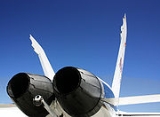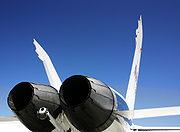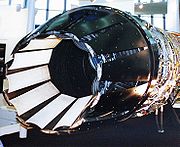
Propelling nozzle
Encyclopedia
A propelling nozzle is the component of a jet engine
that operates to constrict the flow, to form an exhaust jet
and to maximise the velocity of propelling gases from the engine.
Propelling nozzles can be subsonic, sonic, or supersonic. Physically the nozzles can be convergent, or convergent divergent. Convergent-divergent nozzles can give supersonic jet velocity within the divergent section, whereas in a convergent nozzle the exhaust fluid cannot exceed the speed of sound within the nozzle.
Propelling nozzles can be fixed geometry, or they can have variable geometry, to give different throat and exit diameters so as to deal with differences in ambient pressure, flow and engine pressure; thus permitting improvement of thrust and efficiency.
The energy to accelerate the stream comes from the temperature and pressure of the gas- the gas expands adiabatically, when done against a nozzle, this largely reversibly (and hence efficiently
), cools and expands and accelerates the gas. The hotter and higher the pressure the gas entering the nozzle, the faster the exhaust jet can become.
For airbreathing engines, if the fully expanded jet has a higher speed than the aircraft's airspeed, then there is a net rearward momentum gain to the air and there will be a forward thrust on the airframe.
Engines that are required to generate thrust quickly, from idle, use a variable area propelling nozzle in its open configuration to keep thrust to a minimum while maintaining high engine rpm. When thrust is needed, initiating a go-around for example, it is simple and quick to close the nozzle to the high-thrust position.
Simple convergent nozzles are used on many jet engines. If the nozzle pressure ratio is above the critical value (about 1.8:1) a convergent nozzle will choke, resulting in some of the expansion to atmospheric pressure taking place downstream of the throat (i.e. smallest flow area), in the jet wake. Although much of the gross thrust produced will still be from the jet momentum, additional (pressure) thrust will come from the imbalance between the throat static pressure and atmospheric pressure.
In general, narrow convergent nozzles give high speed exhaust, but reduced thrust, whereas wide convergent nozzles give lower speed, but higher thrust.
engines the nozzle
is a fixed size because the differing atmospheric pressure
over the operating altitudes makes little difference to the engine aerodynamics and variable nozzle use is expensive.
Many military combat engines incorporate an afterburner (or reheat) in the engine exhaust system. When the system is lit, the nozzle throat area must be increased, to accommodate the extra exhaust volume flow, otherwise the upstream turbomachinery will rematch aerodynamically. However, some engines do allow a modest rematch when the afterburner is lit, to maximise net thrust.
A variable throat area is achieved by moving a series of overlapping petals, which approximate the circular nozzle cross-section.
duct features that generate supersonic flow. Rockets are an extreme version of this, and the very large area ratio nozzles give rocket engines their distinctive shape.
At high nozzle pressure ratios, the exit pressure is often above ambient and much of the expansion will take place downstream of a convergent nozzle, which is inefficient. Consequently, some jet engines (notably rockets) incorporate a convergent-divergent nozzle, to allow most of the expansion to take place against the inside of a nozzle to maximise thrust. However, unlike the fixed con-di nozzle used on a conventional rocket motor
, when such a device is used on a turbojet engine it has to be a complex variable geometry device, to cope with the wide variation in nozzle pressure ratio encountered in flight and engine throttling. This further increases the weight and cost of such an installation.

, F-111, and Saab Viggen
 For higher performance, it is necessary to use an iris nozzle. This type uses overlapping, hydraulically adjustable "petals". Although more complex than the ejector nozzle, it has significantly higher performance and smoother airflow. As such, it is employed primarily on high-performance fighters such as the F-14, F-15
For higher performance, it is necessary to use an iris nozzle. This type uses overlapping, hydraulically adjustable "petals". Although more complex than the ejector nozzle, it has significantly higher performance and smoother airflow. As such, it is employed primarily on high-performance fighters such as the F-14, F-15
, F-16, though is also used in high-speed bombers such as the B-1B. Some modern iris nozzles additionally have the ability to change the angle of the thrust (see thrust vectoring
).
 Rocket motors also employ convergent-divergent nozzles, but these are usually of fixed geometry, to minimize weight. Because of the much higher nozzle pressure ratios experienced, rocket motor con-di nozzles have a much greater area ratio (exit/throat) than those fitted to jet engines. The Convair F-106 Delta Dart has used such a nozzle design, as part of its overall design specification as an aerospace interceptor for high-altitude bomber interception, where conventional nozzle design would prove ineffective.
Rocket motors also employ convergent-divergent nozzles, but these are usually of fixed geometry, to minimize weight. Because of the much higher nozzle pressure ratios experienced, rocket motor con-di nozzles have a much greater area ratio (exit/throat) than those fitted to jet engines. The Convair F-106 Delta Dart has used such a nozzle design, as part of its overall design specification as an aerospace interceptor for high-altitude bomber interception, where conventional nozzle design would prove ineffective.
civil turbofan
s use an extremely low area ratio (less than 1.01 area ratio), convergent-divergent, nozzle on the bypass (or mixed exhaust) stream, to control the fan working line. The nozzle acts as if it has variable geometry. At low flight speeds the nozzle is unchoked (less than a Mach number
of unity), so the exhaust gas speeds up as it approaches the throat and then slows down slightly as it reaches the divergent section. Consequently, the nozzle exit area controls the fan match and, being larger than the throat, pulls the fan working line slightly away from surge. At higher flight speeds, the ram rise in the intake increases nozzle pressure ratio to the point where the throat becomes choked (M=1.0). Under these circumstances, the throat area dictates the fan match and being smaller than the exit pushes the fan working line slightly towards surge. This is not a problem, since fan surge margin is much better at high flight speeds.
Jet engine
A jet engine is a reaction engine that discharges a fast moving jet to generate thrust by jet propulsion and in accordance with Newton's laws of motion. This broad definition of jet engines includes turbojets, turbofans, rockets, ramjets, pulse jets...
that operates to constrict the flow, to form an exhaust jet
Jet (fluid)
A jet is an efflux of fluid that is projected into a surrounding medium, usually from some kind of a nozzle, aperture or orifice. Jets can travel long distances without dissipating...
and to maximise the velocity of propelling gases from the engine.
Propelling nozzles can be subsonic, sonic, or supersonic. Physically the nozzles can be convergent, or convergent divergent. Convergent-divergent nozzles can give supersonic jet velocity within the divergent section, whereas in a convergent nozzle the exhaust fluid cannot exceed the speed of sound within the nozzle.
Propelling nozzles can be fixed geometry, or they can have variable geometry, to give different throat and exit diameters so as to deal with differences in ambient pressure, flow and engine pressure; thus permitting improvement of thrust and efficiency.
Principles of operation
The primary objective of a nozzle is to raise the pressure in the engine by constricting the flow at the narrowest part (the throat), and then to expand the exhaust stream to, or near to, atmospheric pressure, and form it into a high speed jet to propel the vehicle.The energy to accelerate the stream comes from the temperature and pressure of the gas- the gas expands adiabatically, when done against a nozzle, this largely reversibly (and hence efficiently
Carnot cycle
The Carnot cycle is a theoretical thermodynamic cycle proposed by Nicolas Léonard Sadi Carnot in 1824 and expanded by Benoit Paul Émile Clapeyron in the 1830s and 40s. It can be shown that it is the most efficient cycle for converting a given amount of thermal energy into work, or conversely,...
), cools and expands and accelerates the gas. The hotter and higher the pressure the gas entering the nozzle, the faster the exhaust jet can become.
For airbreathing engines, if the fully expanded jet has a higher speed than the aircraft's airspeed, then there is a net rearward momentum gain to the air and there will be a forward thrust on the airframe.
Engines that are required to generate thrust quickly, from idle, use a variable area propelling nozzle in its open configuration to keep thrust to a minimum while maintaining high engine rpm. When thrust is needed, initiating a go-around for example, it is simple and quick to close the nozzle to the high-thrust position.
Convergent nozzles
Almost all nozzles have a convergent section, as this raises the pressure in the rest of the engine and can give more thrust by acting on the forward sections. However, convergent nozzles end at the end of the convergent section.Simple convergent nozzles are used on many jet engines. If the nozzle pressure ratio is above the critical value (about 1.8:1) a convergent nozzle will choke, resulting in some of the expansion to atmospheric pressure taking place downstream of the throat (i.e. smallest flow area), in the jet wake. Although much of the gross thrust produced will still be from the jet momentum, additional (pressure) thrust will come from the imbalance between the throat static pressure and atmospheric pressure.
In general, narrow convergent nozzles give high speed exhaust, but reduced thrust, whereas wide convergent nozzles give lower speed, but higher thrust.
Afterburners
On non-afterburningAfterBurner
The AfterBurner is a lighting solution for the Game Boy Advance system that was created by Triton-Labs.Originally, portablemonopoly.net was a website created to petition Nintendo to put some kind of light in their Game Boy Advance system...
engines the nozzle
Nozzle
A nozzle is a device designed to control the direction or characteristics of a fluid flow as it exits an enclosed chamber or pipe via an orifice....
is a fixed size because the differing atmospheric pressure
Atmospheric pressure
Atmospheric pressure is the force per unit area exerted into a surface by the weight of air above that surface in the atmosphere of Earth . In most circumstances atmospheric pressure is closely approximated by the hydrostatic pressure caused by the weight of air above the measurement point...
over the operating altitudes makes little difference to the engine aerodynamics and variable nozzle use is expensive.
Many military combat engines incorporate an afterburner (or reheat) in the engine exhaust system. When the system is lit, the nozzle throat area must be increased, to accommodate the extra exhaust volume flow, otherwise the upstream turbomachinery will rematch aerodynamically. However, some engines do allow a modest rematch when the afterburner is lit, to maximise net thrust.
A variable throat area is achieved by moving a series of overlapping petals, which approximate the circular nozzle cross-section.
Convergent-divergent nozzles
Engines capable of supersonic flight have convergent-divergentDe Laval nozzle
A de Laval nozzle is a tube that is pinched in the middle, making a carefully balanced, asymmetric hourglass-shape...
duct features that generate supersonic flow. Rockets are an extreme version of this, and the very large area ratio nozzles give rocket engines their distinctive shape.
At high nozzle pressure ratios, the exit pressure is often above ambient and much of the expansion will take place downstream of a convergent nozzle, which is inefficient. Consequently, some jet engines (notably rockets) incorporate a convergent-divergent nozzle, to allow most of the expansion to take place against the inside of a nozzle to maximise thrust. However, unlike the fixed con-di nozzle used on a conventional rocket motor
Rocket engine nozzles
A rocket engine nozzle is a propelling nozzle used in a rocket engine to expand and accelerate the combustion gases produced by burning propellants so that the exhaust gases exit the nozzle at hypersonic velocities.-History:...
, when such a device is used on a turbojet engine it has to be a complex variable geometry device, to cope with the wide variation in nozzle pressure ratio encountered in flight and engine throttling. This further increases the weight and cost of such an installation.
Divergent nozzle
In a scramjet the air is already moving supersonically before entering the nozzle, so a simple divergent nozzle can be used.Types of nozzles

Ejector nozzles
The simpler of the two is the ejector nozzle, which creates an effective nozzle through a secondary airflow and spring-loaded petals. At subsonic speeds, the airflow constricts the exhaust to a convergent shape. As the aircraft speeds up, the two nozzles dilate, which allows the exhaust to form a convergent-divergent shape, speeding the exhaust gasses past Mach 1. More complex engines can actually use a tertiary airflow to reduce exit area at very low speeds. Advantages of the ejector nozzle are relative simplicity and reliability. Disadvantages are average performance (compared to the other nozzle type) and relatively high drag due to the secondary airflow. Notable aircraft to have utilized this type of nozzle include the SR-71, ConcordeConcorde
Aérospatiale-BAC Concorde was a turbojet-powered supersonic passenger airliner, a supersonic transport . It was a product of an Anglo-French government treaty, combining the manufacturing efforts of Aérospatiale and the British Aircraft Corporation...
, F-111, and Saab Viggen
Iris nozzles

F-15 Eagle
The McDonnell Douglas F-15 Eagle is a twin-engine, all-weather tactical fighter designed by McDonnell Douglas to gain and maintain air superiority in aerial combat. It is considered among the most successful modern fighters with over 100 aerial combat victories with no losses in dogfights...
, F-16, though is also used in high-speed bombers such as the B-1B. Some modern iris nozzles additionally have the ability to change the angle of the thrust (see thrust vectoring
Thrust vectoring
Thrust vectoring, also thrust vector control or TVC, is the ability of an aircraft, rocket or other vehicle to manipulate the direction of the thrust from its engine or motor in order to control the attitude or angular velocity of the vehicle....
).
Rocket nozzles

Low ratio nozzles
At the other extreme, some high bypass ratioBypass ratio
The term bypass ratio relates to the design of turbofan engines, commonly used in aviation. It is defined as the ratio between the mass flow rate of air drawn in by the fan bypassing the engine core to the mass flow rate passing through the engine core....
civil turbofan
Turbofan
The turbofan is a type of airbreathing jet engine that is widely used for aircraft propulsion. A turbofan combines two types of engines, the turbo portion which is a conventional gas turbine engine, and the fan, a propeller-like ducted fan...
s use an extremely low area ratio (less than 1.01 area ratio), convergent-divergent, nozzle on the bypass (or mixed exhaust) stream, to control the fan working line. The nozzle acts as if it has variable geometry. At low flight speeds the nozzle is unchoked (less than a Mach number
Mach number
Mach number is the speed of an object moving through air, or any other fluid substance, divided by the speed of sound as it is in that substance for its particular physical conditions, including those of temperature and pressure...
of unity), so the exhaust gas speeds up as it approaches the throat and then slows down slightly as it reaches the divergent section. Consequently, the nozzle exit area controls the fan match and, being larger than the throat, pulls the fan working line slightly away from surge. At higher flight speeds, the ram rise in the intake increases nozzle pressure ratio to the point where the throat becomes choked (M=1.0). Under these circumstances, the throat area dictates the fan match and being smaller than the exit pushes the fan working line slightly towards surge. This is not a problem, since fan surge margin is much better at high flight speeds.

